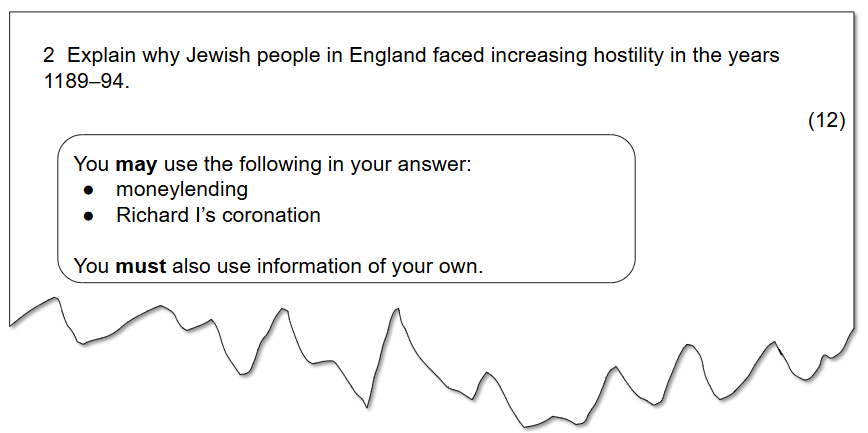The 12 Mark "Explain Why" Question (Edexcel GCSE History): Revision Note
Exam code: 1HI0
Summary of Question 2
Question 2 requires you to provide an analytical explanation of the event, development, theme or factor outlined in the question
This question will require you to use second-order concepts in your answer
Amount of marks | 12 |
|---|---|
The time that you should spend on the question | No more than 20 minutes 5 minutes of planning 10-15 minutes of writing |
An example of the type of question you may encounter can be seen below:

In previous years, this question has focused on the following topics in the reigns of King Richard I and King John:
Year of Exam | Question Topic |
|---|---|
2018 | The Interdict's impact on ordinary people’s lives (opens in a new tab) |
2019 | Richard I's ability to secure his power when he became king (opens in a new tab) |
2020 | King John's loss of Normandy (opens in a new tab) |
2021 | Richard I's failure to recapture Jerusalem (opens in a new tab) |
2022 | John's ability to secure his power when he became king (opens in a new tab) |
2023 | The importance of towns for the economy in medieval England (opens in a new tab) |
2024 | The influence of the Church during the reigns of King Richard I and King John |
What are second-order concepts?
Second-order concepts are thinking tools historians use to explain the past
The second-order concepts are:
Cause and consequence
Change and continuity
Similarities and differences
Historical significance
For the example question, the second-order concept is causation
The example answer asks you to explain what caused increased hostility towards Jewish people
How to answer an "Explain why" question
This question asks you to explain causation, why something happened
You need to demonstrate a clear knowledge and understanding of the events or developments
You will receive two stimulus points
These are areas of knowledge to discuss in your question
If you only discuss these two stimulus points, you cannot access Level 4 (9-12 marks)
You must discuss three areas of knowledge in your answer to access Level 4
You should always plan your answers before writing them. You should consider:
What three areas of knowledge you are going to use
For the example question, you could include the pogroms of 1189-90, religious hatred of Jewish people and moneylending
How these areas demonstrate the causation of the topic outlined in the question
"Explain why" question structure
Your answer should include:
Specific and relevant own knowledge
The second-order concept in the question
A sustained explanation
A logical structure
Your answers could be written in PEEL paragraphs:
P—Make a point about the question
E—Use evidence that supports the point that you have made (K)
Use multiple pieces of evidence from the time period included in the question
E—Explain the question (SOC)
Explain how the evidence resulted in the event or development outlined in the question
L—Link your explanation back to the question
To achieve full marks, you need to repeat this structure three times
The question comprises 12 marks:
6 marks for a wide range of specific knowledge of the period and the topic (K)
6 marks for the analysis of the key second-order concepts (SOC)
Worked example of an "Explain why" question
Worked Example
Explain why Jewish people in England faced increasing hostility in the years 1189–94.
(12)
You may use the following in your answer:
You must also use information of your own. |
Answer:
One reason why Jewish people in England faced increasing hostility in the years 1189–94 was because of their role in moneylending. The Church banned Christians from lending money with interest, so Jewish people became key moneylenders. This made them useful to the king, who, in 1194, created a law that he could collect debts on behalf of any Jewish person who died without a will (K). Many barons and knights were in debt and resented the Jewish people, which increased anger and led to attacks, especially during times of unrest. (SOC).
Another reason was the violence that broke out at Richard I’s coronation in 1189. Jewish leaders arrived with gifts, but they were turned away, and a rumour spread that the king had ordered a general attack. This led to crowds killing Jewish people in London (K). The violence then spread to places like Lincoln and York, where 150 Jewish people were killed. These attacks showed that there was a strong anti-Jewish feeling in England at the time, and Jewish people were not safe in the country (SOC).
A final reason for the hostility was the legal status of Jewish people in England. They were considered the property of the king, which meant they had no legal protection from ordinary law. This meant that they could be taxed or punished as the king saw fit. For example, the Jewish people were heavily taxed to collect Richard I's ransom after he was captured in 1192 (K). Their connection to royal finances made them even more unpopular with the public, as people believed that Jewish people were being protected in return for money. This made them an easy target for hostility and violence (SOC).

Unlock more, it's free!
Did this page help you?